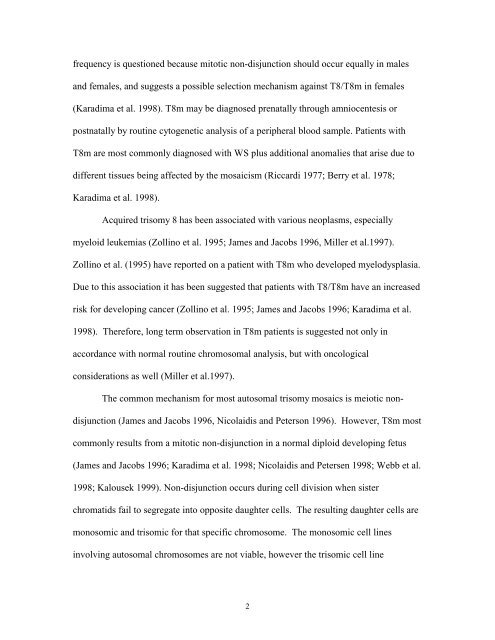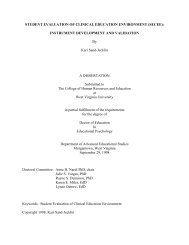TRISOMY 8 MOSAICISM: CELL CYCLE KINETICS AND ...
TRISOMY 8 MOSAICISM: CELL CYCLE KINETICS AND ...
TRISOMY 8 MOSAICISM: CELL CYCLE KINETICS AND ...
You also want an ePaper? Increase the reach of your titles
YUMPU automatically turns print PDFs into web optimized ePapers that Google loves.
frequency is questioned because mitotic non-disjunction should occur equally in males<br />
and females, and suggests a possible selection mechanism against T8/T8m in females<br />
(Karadima et al. 1998). T8m may be diagnosed prenatally through amniocentesis or<br />
postnatally by routine cytogenetic analysis of a peripheral blood sample. Patients with<br />
T8m are most commonly diagnosed with WS plus additional anomalies that arise due to<br />
different tissues being affected by the mosaicism (Riccardi 1977; Berry et al. 1978;<br />
Karadima et al. 1998).<br />
Acquired trisomy 8 has been associated with various neoplasms, especially<br />
myeloid leukemias (Zollino et al. 1995; James and Jacobs 1996, Miller et al.1997).<br />
Zollino et al. (1995) have reported on a patient with T8m who developed myelodysplasia.<br />
Due to this association it has been suggested that patients with T8/T8m have an increased<br />
risk for developing cancer (Zollino et al. 1995; James and Jacobs 1996; Karadima et al.<br />
1998). Therefore, long term observation in T8m patients is suggested not only in<br />
accordance with normal routine chromosomal analysis, but with oncological<br />
considerations as well (Miller et al.1997).<br />
The common mechanism for most autosomal trisomy mosaics is meiotic non-<br />
disjunction (James and Jacobs 1996, Nicolaidis and Peterson 1996). However, T8m most<br />
commonly results from a mitotic non-disjunction in a normal diploid developing fetus<br />
(James and Jacobs 1996; Karadima et al. 1998; Nicolaidis and Petersen 1998; Webb et al.<br />
1998; Kalousek 1999). Non-disjunction occurs during cell division when sister<br />
chromatids fail to segregate into opposite daughter cells. The resulting daughter cells are<br />
monosomic and trisomic for that specific chromosome. The monosomic cell lines<br />
involving autosomal chromosomes are not viable, however the trisomic cell line<br />
2












